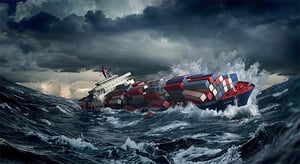 This blog is not about the sinking of the merchant ship, El Faro.
This blog is not about the sinking of the merchant ship, El Faro.
It’s about YOU. It’s about the language you use as a leader.
It’s being mindful. To get you to consider changing your language to achieve better results.
Language is what Captain David Marquet used to take the lowest ranking US Nuclear submarine to the best, as documented in Turn the Ship Around!
Learn that story, watch this video. It’s 6:50. At :08 it shares how organizations follow a leader into disastrous situation. It’s what happened to El Faro.
The story is compelling today because of the disastrous consequences of continuing to use industrial age language (red work) when now, we need to focus on innovating and thinking (blue work) differently
Stop assuming the old ways will come back.
An Engineless Ship Gets Caught in a Category 3 Storm
What’s the sinking of a merchant ship El Faro have to do with leadership? This Smithsonian channel video shares the catastrophic consequences of using the wrong language and decision making.
What the video does not share is the language the Captain of El Faro used to coerce his crew into following his orders, failing to choose the right course, then course correct to avoid a hurricane and keep his crew and cargo safe.
Marquet shares this story in Chapter 1: Losing El Faro, of Leadership Is Language. The El Faro sank Thursday, October 1, 2015.
The chapter is about the power of our programmed language. It’s rooted in the Industrial Age playbook. It’s the same language you may be using now during COVID19, when your business depends on you using a whole new playbook and language. El Faro is worth discussing because we have records of the actual words spoken and the actual actions taken by the captain and crew. Marquet uses the transcript to provide an unparalleled glimpse into the language a team used when faced with life-and-death decisions.
Familiarity Breeds Contempt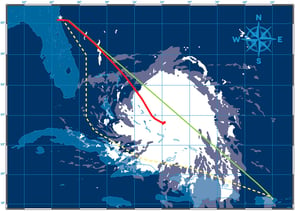
The route the El Faro traveled was familiar. It was their weekly run from Jacksonville, Florida, to San Juan, Puerto Rico, carrying 391 containers and 294 trailers and cars.
Did this make the captain less flexible to change course despite news of Hurricane Joaquin?
Being the most direct, El Faro’s captain, Michael Davidson, chose the fastest course. It was most exposed to the hurricane. An alternate route, the Old Bahama Channel, was 160 miles longer and would take the ship an extra eight hours to traverse. Bahama Channel would’ve put the Bahamas between the ship and the storm, to buffer it from the wind and waves.
Hurricane Joaquin would be the strongest hurricane to hit the Bahamas since 1866.
The sinking of El Faro was the worst U.S. maritime disaster in three decades.
THE LANGUAGE OF INVULNERABILITYMarquez uses multiple examples of the language from the transcript to show how the captain used compliant language to get his crew to follow his orders and intentions.
For example:
The situation steadily worsened, but El Faro had committed to the exposed Atlantic side of the Bahamas eighteen hours earlier. It would have only one more chance to seek shelter on the other side of the Bahamas, at 1:00 Thursday morning. This was fast approaching. About two hours prior to reaching this point, the third mate, on watch, called the captain with a report of the storm’s location and a suggestion: turn south. Here are the words from the third mate to the captain over the internal phone at 11:05 p.m.:
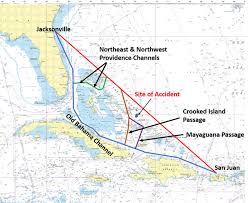 uhh, well it’s—the—the—the current forecast has it uhh—max winds um a hundred miles—an hour. at the center.—umm and if I’m lookin’ at this right—um—and it’s moving at—at two-three-zero at uh five knots. so I assume it stays on that same—moves that same direction for say the next five hours. and uh so it’s advancing toward our trackline—and uhh—puts us real close to it. umm you know like—I could be more specific—I could um—plot that out. but it’s gunna be like real close (and). and uh—don’t know. uh—uh I can give ya a better number and call ya back. we’re lookin’ a meet it at say like four o’clock in the morning. (you know).
uhh, well it’s—the—the—the current forecast has it uhh—max winds um a hundred miles—an hour. at the center.—umm and if I’m lookin’ at this right—um—and it’s moving at—at two-three-zero at uh five knots. so I assume it stays on that same—moves that same direction for say the next five hours. and uh so it’s advancing toward our trackline—and uhh—puts us real close to it. umm you know like—I could be more specific—I could um—plot that out. but it’s gunna be like real close (and). and uh—don’t know. uh—uh I can give ya a better number and call ya back. we’re lookin’ a meet it at say like four o’clock in the morning. (you know).
Immediately after that, he said, “OK.” The captain had told him to stay on course. When the captain gave the order to continue as planned, there was a short pause, and then compliance.
The language is hesitant, self-diminishing, deferential, and nervous. This makes it easy for the captain to reject the unwanted information. The captain’s previous comments were having their intended effect: they suppressed discussion; but of course, they did nothing to suppress doubt or alter the strength of the winds and seas.
REDWORK, BLUEWORK
Marquet explains the two different kinds of work—decision-making (thinking) and execution (doing)—take two opposite approaches to variability. They require two distinctly different mental processes and two different kinds of language.
THE DANGER OF OLD THINKING IN NEW SITUATIONS
The captain’s attitude affects his officers. You can see it in the hesitant, ambiguous, and ineffective language used.
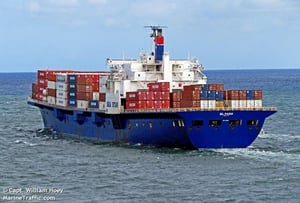 The captain and crew of El Faro were doomed because they’d also been programmed to run certain plays, behave in certain ways, and use certain language. They were trapped by an outdated playbook and unable to see a different way of doing things. Even if they could envision an alternative approach, it would have been extremely difficult to break out of patterns they’d been following their entire careers. We see the angst in the words of the officers as they try—and fail—to break these hardwired patterns.
The captain and crew of El Faro were doomed because they’d also been programmed to run certain plays, behave in certain ways, and use certain language. They were trapped by an outdated playbook and unable to see a different way of doing things. Even if they could envision an alternative approach, it would have been extremely difficult to break out of patterns they’d been following their entire careers. We see the angst in the words of the officers as they try—and fail—to break these hardwired patterns.
- They obeyed the clock when they should have controlled the clock.
- The captain coerced the crew into compliance when he should have collaborated for a commitment.
- The coerced crew complied when they should have made their own commitment.
- They continued following a monolithic plan to take the Atlantic route when they should have completed one section at a time—to the first decision point at the top of the Bahamas and then to the second decision point at Rum Cay.
- They were in prove mode when they should have been in improve mode. This was a result of being in a can-do mode when they should have been in a can-think mode.
- Throughout it all, they conformed to their roles when they should have connected with each other.
EMBRACING VS. REDUCING VARIABILITY.jpg?width=600&name=REDWORK%20VS.%20BLUEWORK%20(Chart).jpg)
Here is the key difference: Thinking benefits from embracing variability. Doing benefits from reducing variability.
What’s your organizations language?
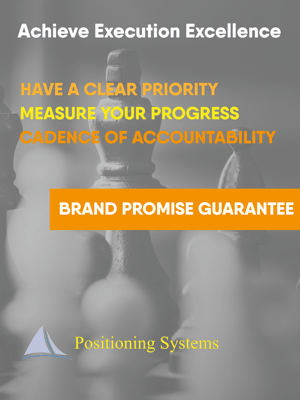 Growth demands Strategic Discipline.
Growth demands Strategic Discipline.
To build an enduring great organization, requires disciplined people, disciplined thought, disciplined action, to produce superior results, and make a distinctive impact in the world.
Discipline sustains momentum, over a long period of time, laying the foundations for lasting endurance.
A winning habit starts with 3 Strategic Disciplines: Priority, Metrics and Meeting Rhythms. Forecasting, accountability, individual, and team performance improve dramatically.
Meeting Rhythms achieve a disciplined focus on performance metrics to drive growth.
Let Positioning Systems help your business achieve these outcomes on the Four most Important Decisions your business faces:
|
DECISION |
RESULT/OUTCOME |
|
PEOPLE |
|
|
STRATEGY |
|
|
EXECUTION |
|
|
CASH |
|
Positioning Systems helps mid-sized ($5M - $250M) business Scale-UP. We align your business to focus on Your One Thing! Contact dwick@positioningsystems.com to Scale Up your business! Take our Four Decisions Needs Assessment to discover how your business measures against other Scaled Up companies. We’ll contact you.
NEXT BLOG – The Seven Sins of Questioning
 In the 511-page transcript, the captain makes 1,203 statements and asks 165 questions over a 25-hour window. Yet many of his questions are not really questions at all:
In the 511-page transcript, the captain makes 1,203 statements and asks 165 questions over a 25-hour window. Yet many of his questions are not really questions at all:
- “You know what I’m saying?” (binary affirmation)
- “What do you want to call this waypoint? How’s Alpha?” (answering own question)
The words were false comfort designed to keep people on task, conforming to their roles, and continuing course. Are the questions you ask your people making them comply or providing them with the energy to drive discretionary effort? We’ll explore the Seven Sins of questioning next blog.






.jpeg?width=150&height=135&name=Hand%20with%20marker%20writing%20the%20question%20Whats%20Next_%20(1).jpeg)

